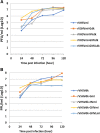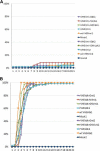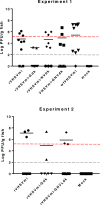The glycoprotein, non-virion protein, and polymerase of viral hemorrhagic septicemia virus are not determinants of host-specific virulence in rainbow trout
- PMID: 30845963
- PMCID: PMC6407216
- DOI: 10.1186/s12985-019-1139-3
The glycoprotein, non-virion protein, and polymerase of viral hemorrhagic septicemia virus are not determinants of host-specific virulence in rainbow trout
Abstract
Background: Viral hemorrhagic septicemia virus (VHSV), a fish rhabdovirus belonging to the Novirhabdovirus genus, causes severe disease and mortality in many marine and freshwater fish species worldwide. VHSV isolates are classified into four genotypes and each group is endemic to specific geographic regions in the north Atlantic and Pacific Oceans. Most viruses in the European VHSV genotype Ia are highly virulent for rainbow trout (Oncorhynchus mykiss), whereas, VHSV genotype IVb viruses from the Great Lakes region in the United States, which caused high mortality in wild freshwater fish species, are avirulent for trout. This study describes molecular characterization and construction of an infectious clone of the virulent VHSV-Ia strain DK-3592B from Denmark, and application of the clone in reverse genetics to investigate the role of selected VHSV protein(s) in host-specific virulence in rainbow trout (referred to as trout-virulence).
Methods: Overlapping cDNA fragments of the DK-3592B genome were cloned after RT-PCR amplification, and their DNA sequenced by the di-deoxy chain termination method. A full-length cDNA copy (pVHSVdk) of the DK-3592B strain genome was constructed by assembling six overlapping cDNA fragments by using natural or artificially created unique restriction sites in the overlapping regions of the clones. Using an existing clone of the trout-avirulent VHSV-IVb strain MI03 (pVHSVmi), eight chimeric VHSV clones were constructed in which the coding region(s) of the glycoprotein (G), non-virion protein (NV), G and NV, or G, NV and L (polymerase) genes together, were exchanged between the two clones. Ten recombinant VHSVs (rVHSVs) were generated, including two parental rVHSVs, by transfecting fish cells with ten individual full-length plasmid constructs along with supporting plasmids using the established protocol. Recovered rVHSVs were characterized for viability and growth in vitro and used to challenge groups of juvenile rainbow trout by intraperitoneal injection.
Results: Complete sequence of the VHSV DK-3592B genome was determined from the cloned cDNA and deposited in GenBank under the accession no. KC778774. The trout-virulent DK-3592B genome (genotype Ia) is 11,159 nt in length and differs from the trout-avirulent MI03 genome (pVHSVmi) by 13% at the nucleotide level. When the rVHSVs were assessed for the trout-virulence phenotype in vivo, the parental rVHSVdk and rVHSVmi were virulent and avirulent, respectively, as expected. Four chimeric rVHSVdk viruses with the substitutions of the G, NV, G and NV, or G, NV and L genes from the avirulent pVHSVmi constructs were still highly virulent (100% mortality), while the reciprocal four chimeric rVHSVmi viruses with genes from pVHSVdk remained avirulent (0-10% mortality).
Conclusions: When chimeric rVHSVs, containing all the G, NV, and L gene substitutions, were tested in vivo, they did not exhibit any change in trout-virulence relative to the background clones. These results demonstrate that the G, NV and L genes of VHSV are not, by themselves or in combination, major determinants of host-specific virulence in trout.
Keywords: Fish; Glycoprotein; Non-virion protein; Polymerase protein; Rhabdovirus; VHSV; Virulence determinant.
Conflict of interest statement
Ethics approval
Fish experiments were conducted in compliance with guidelines provided by the Guide for the Care and Use of Laboratory Animals and the United States Public Health Service Policy on the Humane Care and Use of Laboratory Animals. Fish challenge protocol was approved by the Institutional Animal Care and Use Committee of Western Fisheries Research Center and the studies were conducted in the Center’s Aquatic Biosafety Level 3 wetlab facility following strict containment procedures.
Consent for publication
Not applicable.
Competing interests
The authors declare that they have no competing interests.
Publisher’s Note
Springer Nature remains neutral with regard to jurisdictional claims in published maps and institutional affiliations.
Figures





Similar articles
-
The Nucleoprotein and Phosphoprotein Are Major Determinants of the Virulence of Viral Hemorrhagic Septicemia Virus in Rainbow Trout.J Virol. 2019 Aug 28;93(18):e00382-19. doi: 10.1128/JVI.00382-19. Print 2019 Sep 15. J Virol. 2019. PMID: 31270224 Free PMC article.
-
Heterologous Exchanges of Glycoprotein and Non-Virion Protein in Novirhabdoviruses: Assessment of Virulence in Yellow Perch (Perca flavescens) and Rainbow Trout (Oncorhynchus mykiss).Viruses. 2024 Apr 22;16(4):652. doi: 10.3390/v16040652. Viruses. 2024. PMID: 38675990 Free PMC article.
-
High virulence differences among phylogenetically distinct isolates of the fish rhabdovirus viral hemorrhagic septicaemia virus are not explained by variability of the surface glycoprotein G or the non-virion protein Nv.J Gen Virol. 2014 Feb;95(Pt 2):307-316. doi: 10.1099/vir.0.057448-0. Epub 2013 Nov 4. J Gen Virol. 2014. PMID: 24189623
-
Viral haemorrhagic septicaemia virus in marine fish and its implications for fish farming--a review.J Fish Dis. 2005 Sep;28(9):509-29. doi: 10.1111/j.1365-2761.2005.00654.x. J Fish Dis. 2005. PMID: 16266325 Review.
-
Novirhabdoviruses versus fish innate immunity: A review.Virus Res. 2021 Oct 15;304:198525. doi: 10.1016/j.virusres.2021.198525. Epub 2021 Jul 30. Virus Res. 2021. PMID: 34339774 Review.
Cited by
-
VHSV Single Amino Acid Polymorphisms (SAPs) Associated With Virulence in Rainbow Trout.Front Microbiol. 2020 Aug 27;11:1984. doi: 10.3389/fmicb.2020.01984. eCollection 2020. Front Microbiol. 2020. PMID: 32983011 Free PMC article.
-
Steps of the Replication Cycle of the Viral Haemorrhagic Septicaemia Virus (VHSV) Affecting Its Virulence on Fish.Animals (Basel). 2020 Dec 1;10(12):2264. doi: 10.3390/ani10122264. Animals (Basel). 2020. PMID: 33271890 Free PMC article.
-
Host Jump of an Exotic Fish Rhabdovirus into a New Class of Animals Poses a Disease Threat to Amphibians.Viruses. 2024 Jul 25;16(8):1193. doi: 10.3390/v16081193. Viruses. 2024. PMID: 39205167 Free PMC article.
-
Effect of the Viral Hemorrhagic Septicemia Virus Nonvirion Protein on Translation via PERK-eIF2α Pathway.Viruses. 2020 Apr 30;12(5):499. doi: 10.3390/v12050499. Viruses. 2020. PMID: 32365817 Free PMC article.
-
Naturally occurring substitution in one amino acid in VHSV phosphoprotein enhances viral virulence in flounder.PLoS Pathog. 2021 Jan 19;17(1):e1009213. doi: 10.1371/journal.ppat.1009213. eCollection 2021 Jan. PLoS Pathog. 2021. PMID: 33465148 Free PMC article.
References
-
- Smail DA, Snow M. Viral haemorrhagic septicaemia. 2011. In: Woo PTK, Bruno DW, eds. Fish diseases and disorders, Vol. 3, Viral, bacterial, and fungal infections. 2nd Edition. Wallingford, U.K.: CAB International; pp. 110–142.
-
- World Organisation for Animal Health. 2018. Manual of diagnostic tests for aquatic animals. Viral haemorrhagic septicaemia. World Organisation for Animal Health, Paris, France.
-
- ICTV Virus Taxonomy, 2018 release, available online at https://talk.ictvonline.org/taxonomy.
Publication types
MeSH terms
Substances
LinkOut - more resources
Full Text Sources
Research Materials

